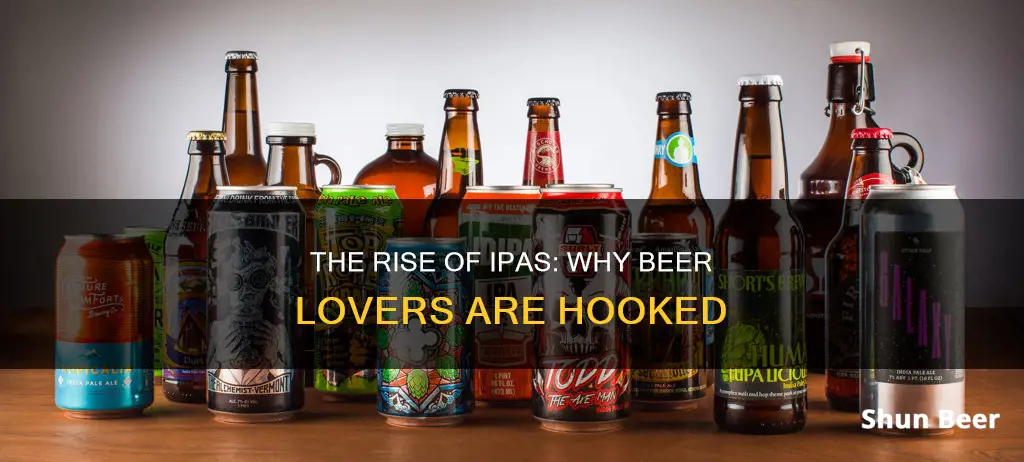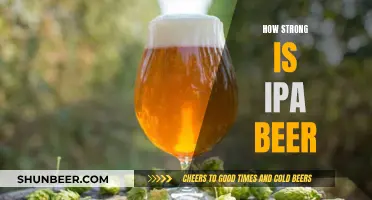
India Pale Ale (IPA) is a hoppy beer style within the broader category of pale ale. The name comes from British sailors on six-month voyages to India, who wanted a beer that could withstand changing temperatures and remain drinkable. IPAs are known for their bitter taste, due to their higher-than-average hop content, but they also have fruit and citrus notes. They are also known for their higher alcohol content. In recent years, IPAs have become extremely popular, with some estimates suggesting that over 40% of craft beer brewed in the US can be classified as an IPA. This is due to a range of factors, including the fact that they are relatively easy to make, their cultural significance in North America, and their ability to mask brewing flaws.
| Characteristics | Values |
|---|---|
| History | British sailors on six-month voyages to India in the 18th century needed a beer that could withstand changing temperatures and hot, humid climates. |
| Ingredients | Hops, malt, barley, yeast, water |
| Flavour | Hoppy, malty, bitter, sweet, fruity, citrusy, earthy, piney |
| ABV | Typically 5% but can be 7% or more for Double IPAs and above 10% for Triple IPAs |
| Calories | 170-240 per serving |
| Carbohydrates | Around 30g per serving |
| Popularity | One of the most popular beer styles in the UK and the US, with over 40% of craft beer in the US being IPAs |
What You'll Learn
- IPAs are bitter, but the style is evolving to reduce bitterness
- They're filling, but that's because they're aromatic and flavourful
- They're often high-ABV, but there are lower-ABV IPAs available
- They're not a good showcase of brewing ability because there are so many on the market
- They're best served at around 50°F, not straight from the fridge

IPAs are bitter, but the style is evolving to reduce bitterness
IPAs, or India Pale Ales, are known for their bitter taste due to their higher-than-average hops content. Hops are what make IPAs so widely known, with their distinct hoppy aromas and flavours. However, the style is evolving, and brewers are increasingly experimenting with new techniques to reduce the perception of bitterness in their beers and bring forward other flavours.
The bitterness of a beer can be measured using International Bitterness Units (IBU), with most IPAs ranging from 40 to 60 on this scale. However, the perceived bitterness of a beer can be quite different from its IBU rating. Factors such as a beer's alcohol content, malt profile, and residual sugars can affect how bitter it tastes. For example, an imperial stout with 85 IBUs may not taste bitter at all due to the sweetness of the beer balancing out the bitterness.
The evolution of the IPA style is evident in the growing popularity of New England-style or East Coast IPAs, which are known for their fruit-forward flavours and less bitter taste compared to traditional West Coast IPAs. Brewers are also exploring new hop varieties and techniques to emphasise the creative results of the oils in hops, achieving notes of berries, melon, grapefruit, and white wine grapes.
This shift in the IPA style is a response to consumer preferences and a desire to create a broader range of options for those who dislike the intense bitterness typically associated with IPAs. By reducing the perception of bitterness, brewers are able to highlight the unique flavours and aromas that hops can impart, creating a more nuanced and accessible drinking experience.
The changing landscape of the beer industry, driven by the rise of craft breweries, has also played a role in the evolution of IPAs. With a focus on innovation and creating new flavours, craft brewers are pushing the boundaries of what an IPA can be, challenging traditional notions of bitterness in the process.
The Mystery Widget in Guinness Beer
You may want to see also

They're filling, but that's because they're aromatic and flavourful
IPAs are strong and flavourful, with a unique bitterness that divides opinion. They are aromatic and flavourful because of the hops used in their brewing process. Hops are flowers from the Humulus Lupulus plant, and they act as antiseptics and natural preservatives. They also impart bitterness and aromatics, ranging from guava and grapefruit to pine nuts and fresh-cut herbs.
The ale yeast used in IPAs also contributes to their intense aromas. The combination of hops and ale yeast results in a beer style that is aromatic and flavourful.
Craft beer drinkers enjoy the complex flavours and aromas of IPAs and savour them slowly to appreciate every nuance. IPAs are typically stronger than average beers, so drinking them slowly allows one to appreciate the flavours and avoid overconsumption.
The bold flavours and aromas of IPAs are part of their appeal and why they have become so popular. The intense bitterness of IPAs may not be for everyone, but the style is constantly evolving, with new techniques being used to reduce bitterness and bring out other flavours.
While some may find IPAs too filling to drink in large quantities, slowing down and savouring the complex flavours and aromas of a well-crafted IPA can be a rewarding experience for beer enthusiasts.
Guinness' Surprising Health Benefits Over Other Beers
You may want to see also

They're often high-ABV, but there are lower-ABV IPAs available
India Pale Ale (IPA) is a hoppy beer style within the broader category of pale ale. IPAs are often associated with high alcohol content, but this is not always the case. The alcohol content of an IPA depends on the specific type.
IPAs with lower alcohol content are typically easier to drink as they are lighter than their higher alcohol-by-volume (ABV) counterparts. This can be both positive and negative, depending on the drinker's perspective. Some beer drinkers enjoy being able to sip on a few more beers without feeling weighed down, but they might find themselves tipsier than they intended.
On the other hand, IPAs with higher alcohol content will usually feel heavier to drink. After just a drink or two, you could find yourself feeling sluggish or weighed down. Instead of feeling ready for a night out, you might just want a quick nap on the couch.
The ABV of an IPA can vary significantly, with some hovering around 5% and others reaching 7% or more. Double IPAs, for example, are a stronger variant with alcohol content typically above 7.5% ABV.
It is worth noting that the higher alcohol content in IPAs can also contribute to a more intense drinking experience. The combination of higher ABV and the distinct hoppy flavour of IPAs can create a rich and full-bodied drinking experience that appeals to many beer enthusiasts.
Guinness Beer: Pressurizing the Magic Balls
You may want to see also

They're not a good showcase of brewing ability because there are so many on the market
India Pale Ale (IPA) is a hoppy beer style within the broader category of pale ale. The name comes from British sailors on six-month voyages to India who wanted a beer that could withstand changing temperatures and remain palatable.
IPAs have become increasingly popular over the years, with some sources stating that they are "synonymous with the craft beer revolution". However, not everyone is a fan of this variety of beer. One common criticism of IPAs is that they are "not a good showcase of brewing ability because there are so many on the market". This criticism stems from the idea that the popularity of IPAs has led to a flood of options on the market, and not all of them are well-crafted.
The perception that IPAs are easy to brew and, therefore, not indicative of a brewer's skill, is a common one. Some beer enthusiasts believe that the strong flavours and high alcohol content of IPAs can mask brewing flaws and that the addition of a large quantity of hops can cover up minor mistakes and off-flavours. This view is supported by the fact that IPAs are top-fermented and, therefore, more forgiving when it comes to fermentation and maturation temperatures.
However, others disagree, arguing that while IPAs may be simple to brew, they are not easy to brew exceptionally well. The belief is that creating a well-balanced IPA with the right mix of hops, malt, and yeast requires a great deal of skill and expertise. The fact that there are so many mediocre IPAs on the market only serves to highlight the breweries that truly excel at crafting this style of beer.
In conclusion, while the proliferation of IPAs may give the impression that they are not a showcase of brewing ability, the opposite may be true. The abundance of options allows consumers to discern the exceptional from the ordinary, and appreciate the skill and artistry that goes into crafting a truly outstanding IPA.
Exploring IPAs: Beer Styles and Tasting Notes
You may want to see also

They're best served at around 50°F, not straight from the fridge
The optimal temperature for serving India Pale Ales (IPAs) is a topic of some debate, but most sources agree that they are best served at around 45–50°F (7–10°C). Serving IPAs straight from the fridge is likely to be too cold and will negatively impact the drinking experience.
When beer is served too cold, it becomes difficult to taste or smell its full range of flavours and aromas. This is because the cold temperature causes the carbon dioxide in the beer to become more soluble, resulting in less fizz and aroma. Additionally, an ice-cold beer can actually lower the temperature of your tongue, reducing your ability to taste the full extent of the beer's flavours.
For IPAs, a temperature of 45–50°F strikes a balance between refreshment and allowing the broader range of flavours to be appreciated. Serving IPAs at this slightly warmer temperature enhances their piney and citrusy flavours. It is worth noting that the exact temperature will depend on the beer's bitterness and alcohol levels, with higher alcohol content generally benefiting from a slightly higher serving temperature.
Allowing your IPA to warm up slightly before drinking can make a significant difference in unlocking its full flavour potential. So, if you're looking to get the most out of your IPA-drinking experience, consider taking it out of the fridge and letting it warm up for a few minutes before popping it open.
Craft Beer Enthusiasts: Guinness Blonde Alternatives
You may want to see also
Frequently asked questions
India Pale Ale (IPA) is a hoppy beer style within the broader category of pale ale. IPAs are popular because they are synonymous with the craft beer revolution, and they are known for their distinct, hoppy flavour profile.
India Pale Ale (IPA) is a style of beer that falls within the broader category of pale ale. It is characterised by its use of hops, which give it a distinct aroma and flavour.
IPAs are popular for a variety of reasons. Firstly, they have a distinct and bold flavour profile that many people enjoy. Secondly, they are synonymous with the craft beer revolution, and drinking an IPA can be seen as a way to support small breweries and organisations. Additionally, the high alcohol content of IPAs can contribute to their popularity.
There are several types of IPAs, including West Coast IPA, New England IPA (also known as Hazy IPA), Double IPA, and Triple IPA. Each of these varieties has distinct characteristics in terms of flavour, appearance, and alcohol content.







